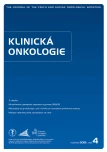Use of Fludarabine for the Treatment of Indolent Lymphoma with Chylothorax
Authors:
Wild Alexander 1,2; Holasová Juliana 1,2; Králiková Eva 1
Authors‘ workplace:
Hematologické oddelenie, FNsP F. D. Roosevelta Banská Bystrica
1; LF SZU v Bratislave
2
Published in:
Klin Onkol 2018; 31(4): 301-304
Category:
Case Report
doi:
https://doi.org/10.14735/amko2018301
Overview
Background:
Although chylothorax is rare in patients with malignant lymphoma, it has been reported in cases with mediastinal lymphadenopathy, a bulky retroperitoneal mass, or thoracic ducts blocked by lymphocytes in chronic lymphocytic leukemia (CLL). The clinical picture is not specific. Patients become more immunocompromised and malnourished after repeated evacuations. Chylothorax is usually diagnosed when the triglyceride level is > 1.24 mmol/l and the cholesterol level is < 5.18 mmol/ l in the effusion. Chemotherapy or radiotherapy of the associated malignant tumors has been used as the first-line treatment of malignant chylothorax. The responses of chylothorax after 3–8 chemotherapy courses have been described. A few cases of indolent lymphoma associated with chylothorax that were treated with fludarabine-based chemotherapies with various outcomes have been published. Total parenteral nutrition or a low-fat diet combined with ingestion of medium-chain triglycerides can accelerate remission of chylothorax.
Observation:
This study presents two cases with chylothorax associated with a bulky abdominal mass in relapsed CLL and newly diagnosed follicular lymphoma, respectively. No further evacuations were required after one and three courses of fludarabine plus cyclophosphamide with/without rituximab in the patients with CLL and follicular lymphoma, respectively. Chylothorax disappeared after five courses, and a partial or complete response of malignant lymphoma was achieved. The response lasted for 30 months in the patient with CLL and has persisted throughout maintenance therapy with rituximab in the patient with follicular lymphoma.
Conclusion:
Limited experience indicates that fludarabine-based regimes can result in rapid regression of chylothorax, in addition to treating indolent lymphoma, which prevents patients becoming more malnourished and immunocompromised.
Key words:
lymphoma – fludarabine – chylothorax
The authors declare they have no potential confl icts of interest concerning drugs, products, or services used in the study.
The Editorial Board declares that the manuscript met the ICMJE recommendation for biomedical papers.
Submitted: 2. 2. 2018
Accepted: 20. 5. 2018
Sources
1. McGrath EE, Blade Z, Anderson PB. Chylothorax: aetiology, diagnosis and therapeutic options. Resp Med 2010; 104 (1): 1–8. doi: 10.1016/j.rmed.2009.08.010.
2. Scholtz GA, Sirbu H, Semrau S et al. Persisting right-sided chylothorax in a patient with chronic lymphocytic leukemia: a case report. J Med Case Reports 2011; 5: 492. doi: 10.1186/1752-1947-5-492.
3. Van De Voorde L, Vanneste B, Borger J et al. Rapid decline of follicular lymphoma-associated chylothorax after low dose radiotherapy to retroperitoneal lymphoma localization. Case Rep Hematol 2014; 2014: 684689. doi: 10.1155/2014/684689.
4. Novotný J, Eliáš P. Přínos kontrastního CT v detekci maligní etiologie pleurálního výpotku. Ces Radiol 2007; 61 (4): 392–399.
5. Thomas LC, Maida MJ, Martinez-Outschoorn U et al. Chronic lymphocytic leukemia/small lymphocytic lymphoma with pancytopenia and chylothorax. Sem Oncol 2001; 38 (2): 165–170. doi: 10.1053/j.seminoncol.2010.11.013.
6. Tanriverdi H, Uygur F, Tilkan OK et al. Chylothorax due to leukemic infiltration in a patient with chronic lymphocytic leukemia. Respir Med Case Rep 2015; 16: 131–133. doi: 10.1016/j.rmcr.2015.09.006.
7. Jagosky M, Taylor B, Taylor SP. A case of chyloperitoneum secondary to follicular lymphoma and a review of prognostic implications. Case Rep Hematol 2016; 2016: 4625819. doi: 10.1155/2016/4625819.
8. Janjetovic S, Janning M, Daukeva L et al. Chylothorax in a patient with Hodgkin’s lymphoma: a case report and review of the literature. Tumori 2013; 99 (3): e96-e99. doi: 10.1700/1334.14813.
Labels
Paediatric clinical oncology Surgery Clinical oncologyArticle was published in
Clinical Oncology

2018 Issue 4
Most read in this issue
- Monoclonal Gammopathy of Undetermined Significance (MGUS)Monoclonal Gammopathy of Undetermined Significance (MGUS)
- Carcinoma of Unknown Primary in Head and Neck Region
- Occurrence and Antibiotic Resistance of Enterobacteriaceae in Acute Leukemia Patients
- Use of Salivary MicroRNAs for Diagnosis of Solid Cancers
